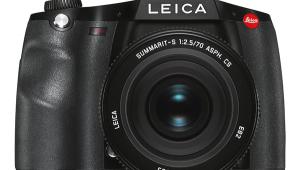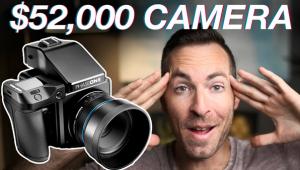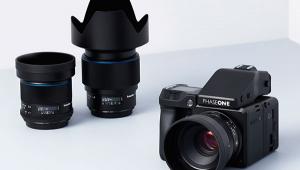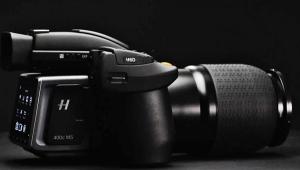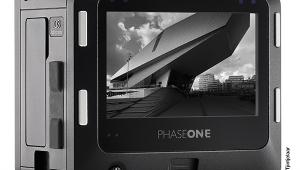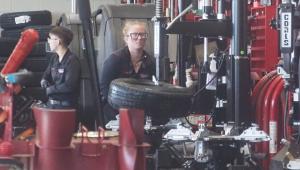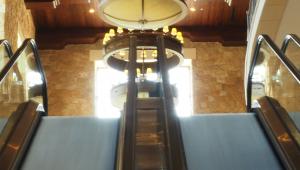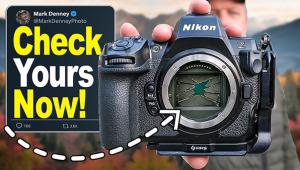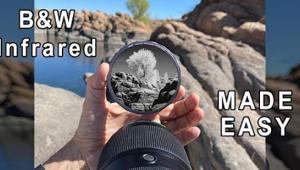Cameras; Rangefinder 35mms, Medium & Large Format Cameras
 Perhaps the biggest surprise of the show, at least in conventional photography, was the new 35mm rangefinder stereo camera from Horseman. This shoots stereo pairs in the standard format--2x23x27mm in standard stereo mounts--so they can be projected or viewed with the binocular viewer that is supplied with the camera.
Perhaps the biggest surprise of the show, at least in conventional photography, was the new 35mm rangefinder stereo camera from Horseman. This shoots stereo pairs in the standard format--2x23x27mm in standard stereo mounts--so they can be projected or viewed with the binocular viewer that is supplied with the camera.
If the camera itself looks oddly familiar, it's because it's based on the Fujiblad X-Pan; Fuji in Japan, Hasselblad elsewhere in the world. Because of the very wide format of the X-Pan, it is possible to split the film gate and put both halves of the stereo image behind the same vertical-travel metal shutter, ensuring absolutely even exposure at a gratifyingly wide range of speeds (8 seconds to 1/1000 sec). Of course, it has to be vertical-travel, because a horizontal-travel shutter would expose one image just long enough after the other to provoke some thoroughly headache-inducing stereo anomalies. The twin, fixed lenses are 38mm f/2.8 EBC Fujinons, slightly long for the format, but the result is very convincing stereo indeed. It's fully battery dependent, with electric film wind as well as an electric shutter, just like the camera on which it is based, but for fairly obvious reasons it has only one format. The only real drawback is the price, $4995, though you do get the stereo viewer thrown in.
 |
|
|
|
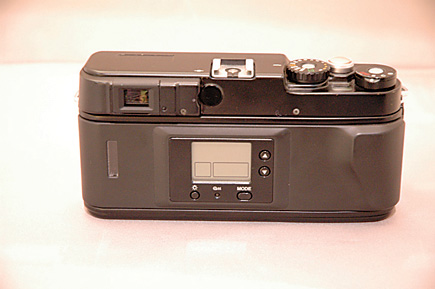 |
|
|
|
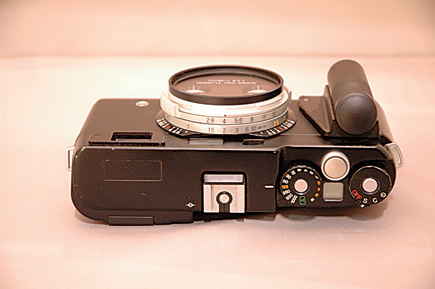 |
|
|
|
 |
|
|
Otherwise, the only news in rangefinder cameras was the promise of future news. The Leica Digital M is now more than just a rumor, and I've been promised that I can get my hands on one even before the official launch at photokina 2006, though of course, I will have to respect the embargos for publication. Even so, it means that Shutterbug readers will be among the first to get the benefit of a real, hands-on test.
The 250th anniversary of the founding of Voigtländer was also scheduled to bring interesting announcements, but unfortunately, we could not get these before the press deadline for this issue. We hope to bring you more information next month. And while there should be some new Zeiss Ikon announcements at photokina, the only real news at PMA was that Hasselblad USA is no longer the official distributor. There was no information on who might replace them, at least at the show, but the smart money is on direct distribution by Zeiss alongside their new manual-focus lenses for SLR cameras.
At Hasselblad, the real news in medium format was the launch of the CFV 16-megapixel back (36.7mm square sensor) that is not only compatible with classic C, F, and C/F film cameras, including the immortal 500C, but even looks the part, with a bright-edge black finish that echoes the lines of the camera. It is perhaps rather large and ungainly as compared with the svelte rollfilm backs that we all know and love, and which arguably deliver 50+ megapixels, but if it allows you to take digital images using one of the finest cameras in the world, back compatible to the 1950s, with Hasselblad's wonderful Zeiss lenses, who's complaining? There's also a 39-megapixel version of the modern H1 camera, the H2D-39, which gives you all sorts of automation as well, but as any half-competent photographer should be able to determine the optimum shutter speed, aperture, and focus without relying on automation, there's still a lot to be said for the new back on an old camera, even if it does have less than half the megapixels.
 |
|
|
|
 |
|
|
Over at Rollei, there's new software, Sinar cross-compatibility, and new hardware/software bundles with the 6008-series SLRs, plus an autofocus 135mm f/4 Schneider Tele-Xenar, but as far as I was concerned, the new Tele-Rollei was all I had eyes for. This has twin 135mm f/4 lenses: a Heidosmat on top and a Schneider Tele-Xenar in a modified Copal shutter on the bottom. It focuses a lot closer than the original Tele-Rollei: around 1.5 meters (5 ft) instead of 2.6 meters (close to 9 ft). This makes it even more useful for portraiture than before: I suspect that very few will be used for gathering "hard" news, which was apparently one of the uses for the original. Rollei themselves see it primarily as a portrait camera, where continuous viewing even during the exposure is very useful, though they admitted that plenty will also sell straight to collectors who will never use them at all, or who will at most run a few rolls through them. The Copal is very slightly noisier than the original Compur, especially at the lower speeds (both are about the same at 1/500), but this is still a very quiet camera.
 |
|||
|
|||
 |
 |
||
|
|
||
 |
|||
|
|||
Rollei also had a brilliantly simple accessory in their standard, current bayonet IV mount: a parallelogram arm for switching filters from the viewing lens to the taking lens. This is easier to illustrate than to describe. You mount the filter in the moving part, and swing it up or down according to where you want it. When you see it, you wonder why someone didn't invent it in the '30s: it's that clever, that simple, and (once you have seen it) that obvious. Which is one definition of genius.
 |
|
|
On the Phenix stand was another 617, the WIDEPAN. There are quite a few Chinese-built 617s now, but this one is particularly elegant and well finished. The locks on the removable back were among the most elegant I have ever seen, like something from Germany in the '50s, and there is even a body release, convenient for the right index finger. What is more, the counter is mechanical, not red window like most of the less expensive Chinese models, so it takes 220 as well as 120 (the pressure plate is repositionable). The lens is a fixed 90mm f/5.6 Schneider Super Angulon, but an interchangeable-lens model is promised. Price in China is an astonishingly reasonable $4000, but this will presumably rise for the US market.
- Log in or register to post comments

